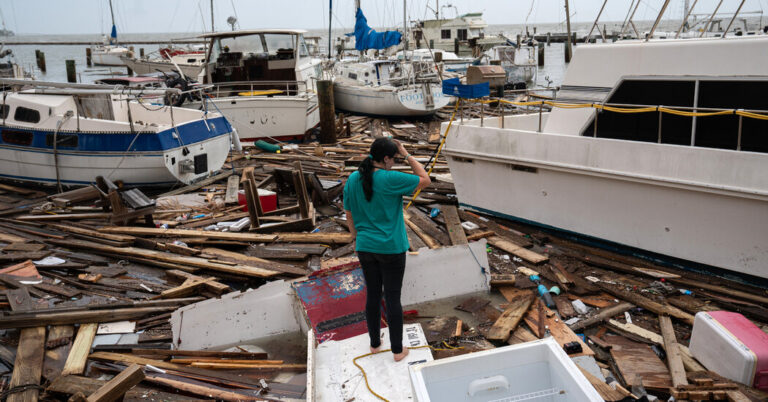Opinion | The Destruction of Gaza’s Health Care Promises Grave Consequences
I started training to be a doctor in the aftermath of the gulf war. It was a dark time to commit to a career of healing. U.S. sanctions and relentless bombings had decimated our medical infrastructure and endangered our access to medical supplies. Surrounded by devastation, we fought to heal, to operate, to comfort — often with the barest of resources. Every day was a battle in itself, trying to save lives as our facilities crumbled around us.
The U.S. invasion of Iraq in 2003 pushed a teetering health care system to the brink. Bombings and counterinsurgency operations relentlessly flooded hospitals with injured civilians. Overwhelmed with patients and scrambling for time, doctors and other medical workers around the country were forced to make heart-wrenching decisions about whom, realistically, they could save. Direct attacks on hospitals perhaps dealt the final blow to Iraq’s crumbling health care capabilities, once a source of pride across the Middle East.
Now the world is witnessing another war in which a health care system that was already under distress is being destroyed. I see alarming parallels between what I witnessed in Iraq to what is happening in Gaza, from widespread shortages of essential supplies to soaring infection rates to military targeting of hospitals. When health care services, infrastructure and expertise are destroyed during war, they are often lost forever. In their absence, a permanent public health crisis threatens the lives of survivors who have nowhere else to go. As someone who has devoted much of his career to documenting the grave consequences that come from attacking health care, I cannot help but feel a haunting déjà vu in Gaza.
Although targeting hospitals and health care facilities during war is illegal under the Geneva Conventions, with very narrow exceptions, these attacks have increased sharply over the past two decades, especially under the aegis of fighting terrorism. In 2021 the World Health Organization reported that at least 930 health care workers were killed in 600 attacks during the Syrian civil war. Syrian and Russian forces have seemingly attacked hospitals under the claim that they were striking terrorist targets.
Comparable incidents have occurred in several other conflict zones, including Yemen, Sudan, Ethiopia and Libya. A particularly haunting episode was the U.S. bombing of Doctors Without Borders’ trauma hospital in Kunduz, Afghanistan, in 2015, killing at least 42 people. The United States later admitted that it was a tragic mistake; the hospital that was struck was not, in fact, controlled by the Taliban, as was originally reported. Russia has conducted over 1,110 attacks on health care operations in Ukraine since it began its invasion — the most that the W.H.O. has counted in any humanitarian crisis to date. These attacks have included bombings of hospitals, torture of medical personnel and assaults on ambulances.
The concept of civilian collateral damage has become disturbingly normalized, resulting in the targeting of hospitals, the easy killing of the sick or injured and the erosion of civilian health care during wartime. When it comes to global conflict, hospitals are no longer safe havens. With the right justifications, they readily become battle sites.
When hospitals are turned into battlegrounds, they cease to provide care, paving the way for health crises that persist long after the guns fall silent. Last February, I returned to Iraq to further study war’s impact on the global surge of antibiotic-resistant bacteria. Over the past decade, the U.N. has been sounding the alarm on antimicrobial resistance — the resistance of bacteria to antibiotics and other drugs — predicting it could cause 10 million deaths annually by 2050.
In conflict zones, the collapse of health care infrastructure and the unchecked use of antibiotics fuel the spread of resistant bacteria far beyond immediate areas of hostilities. One example is Iraqibacter, or Acinetobacter baumannii, a superbug that was brought back to U.S. hospitals by injured troops who served in Iraq and Afghanistan. Iraqibacter infects wounds and spreads through bloodstreams to cause a range of medical woes, including sepsis, meningitis, loss of limbs and death. A 2022 study published in The Lancet lists Iraqibacter as one of the six deadliest among drug-resistant pathogens. Together, these six pathogens are responsible for millions of deaths.
During my month in Iraq, I spent time among Mosul’s ruins, reconnecting to the city of my childhood memories and my father’s birth. The 2016-17 battle of Mosul is said to be one of the deadliest urban military operations since World War II — a comparison that is also eerily being applied to Israel’s offensive in Gaza. For nine long months, Iraqi security forces backed by the United States fought to reclaim the city from ISIS fighters. The battle, marked by intense aerial bombardment, saw health care facilities become central, intentional battlegrounds. Nine of the 13 public medical centers serving Mosul and its surrounding community were severely damaged.
I took an afternoon to drive by the remains of Al Shifa hospital complex, once the city’s largest. Where there was once a sprawling main hospital, I saw nothing but a shell. The gutted structure, exposing concrete slabs and twisted rebar, stood on the Tigris River’s western bank as a somber testament to the city’s loss. Six years after the battle, the scars of war remain visible everywhere. Neighborhoods erased during the war have yet to be rebuilt. The city’s public hospitals are in ruins, despite reconstruction efforts, and many displaced families have yet to return home. Local clinics are still overwhelmed, and antibiotic resistance is one of the highest in the region. Mosul’s sewage — a dangerous cocktail of toxic waste and debris — poses a threat to those already suffering from health issues.
Mosul’s destruction not only highlights the immediate, physical impact of war but also how challenging it is to rebuild essential services in its wake. It is a living testament to how health care crises tend to compound one another, creating incredibly dangerous environments long after the cessation of hostilities.
Gaza’s plight has eclipsed the devastation I witnessed in Mosul and other conflict zones, with death and injury rates soaring to unthinkable levels. Marooned in what amounts to a public health dystopia, the residents of the Gaza Strip cannot flee, as in other conflicts. In northern Gaza, nearly all hospitals have shut down because of the lack of electricity, working sewerage, clean water, food and essential health care supplies. Doctors struggle to provide care to a young population amid severe shortages. They are encountering unusual injuries, potentially indicative of new weapons being tried in the conflict, all while being killed themselves. A Doctors Without Borders report published by the medical journal The Lancet last month warned that antimicrobial resistance may lurk as a “silent threat” in the enclave. Infants are in neonatal care while tanks and snipers are at the hospital’s gates. Worst of all, there seems to be no end in sight.
Since I began writing this essay, there have been new reports of widespread diseases ravaging Gaza. As if the aerial destruction weren’t enough, Israel’s assault on Gaza has set off a public health time bomb. The imperative is clear: The war must be brought to an immediate end, substantial humanitarian aid must be poured in, and Gaza’s medical and surgical services must be restored. The world must not stand for the targeting of the sick and dying — no matter what the military justification is.
Omar Dewachi is the author of “Ungovernable Life: Mandatory Medicine and Statecraft in Iraq.” He is a medical anthropologist and global health practitioner based at Rutgers University.
The Times is committed to publishing a diversity of letters to the editor. We’d like to hear what you think about this or any of our articles. Here are some tips. And here’s our email: [email protected].
Follow the New York Times Opinion section on Facebook, Instagram, TikTok, X and Threads.
Check out our Latest News and Follow us at Facebook
Original Source







